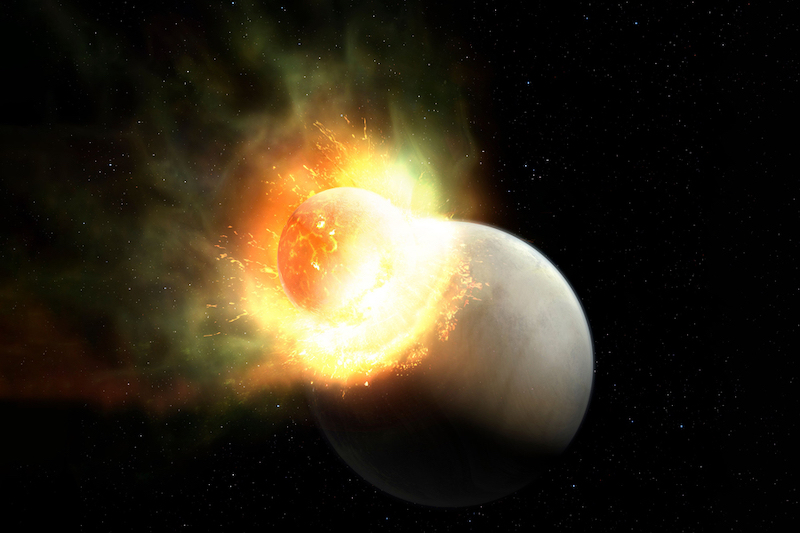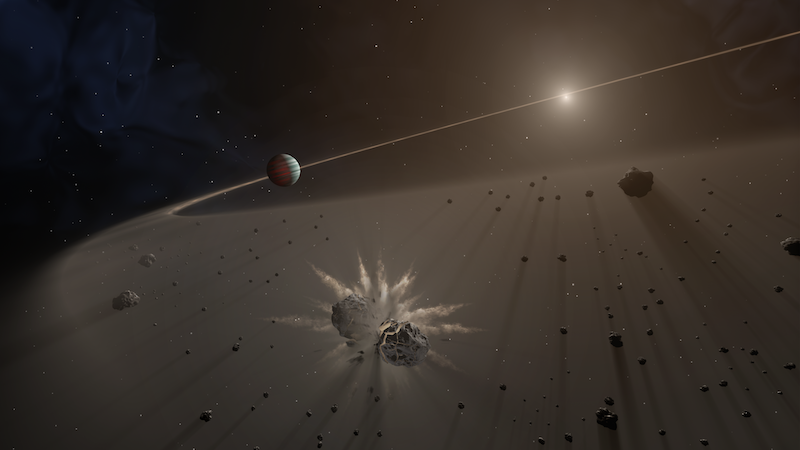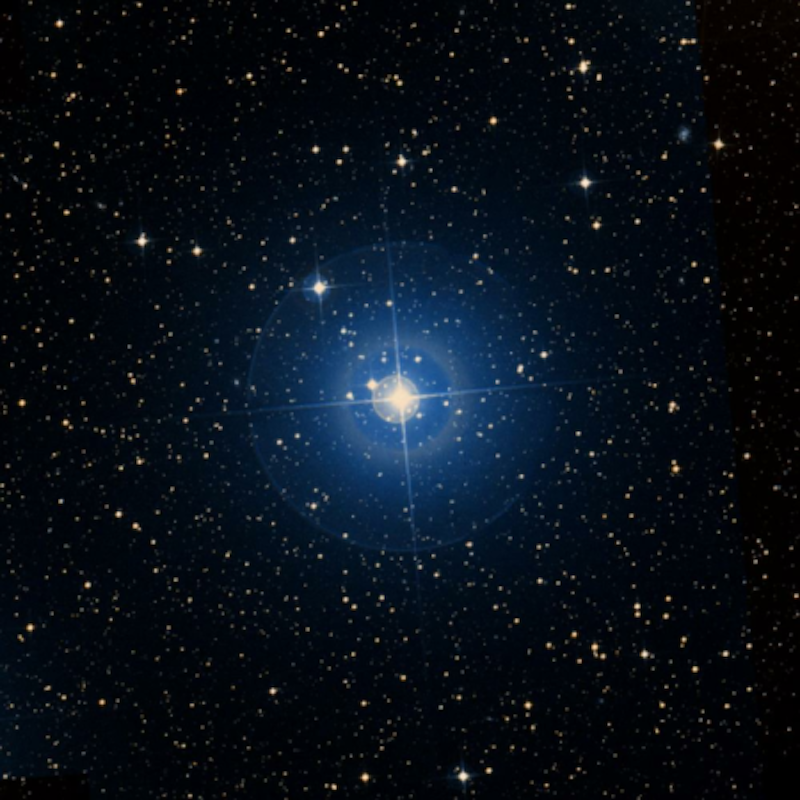
Our early solar system was a chaotic and violent place, with rocky bodies colliding in big and small smashups. In fact, such collisions gradually formed the planets and moons we see today. On October 20, 2021, astronomers said they found evidence for how a young exoplanet lost its atmosphere in a giant impact thousands of years ago.
The peer-reviewed journal Nature published the findings of researchers from MIT, the National University of Ireland Galway, Cambridge University and other institutions on October 20, 2021.
How an exoplanet lost its atmosphere
Notably, the evidence didn’t come from the planet itself, but from a ring of dust and gas orbiting the star HD 172555. These rings, or disks, are called circumstellar disks. The star is about 95 light-years from Earth and estimated to be only 23 million years old. The star is still in its infancy.
The dust and gas provided clues pointing to a massive collision, which scientists estimated occurred around 200,000 years ago. According to the scientists, it involved a protoplanet – a young, still-forming “embryo” planet – about the size of Earth, and a smaller object that impacted it.
Researchers estimated the speed of the impacting object at more than 22,000 miles per hour (about 10 kilometers per second). The collision likely stripped away a large portion of the planet’s atmosphere in the process.

As lead author Tajana Schneiderman in the Department of Earth, Atmospheric and Planetary Sciences at MIT stated:
This is the first time we’ve detected this phenomenon, of a stripped protoplanetary atmosphere in a giant impact. Everyone is interested in observing a giant impact because we expect them to be common, but we don’t have evidence in a lot of systems for it. Now we have additional insight into these dynamics.
Unusual minerals and carbon monoxide
The researchers were studying the dust and gas around the star when they found something strange. Actually, a couple of things. First, the dust grains contain an abundance of unusual minerals. Moreover, the dust grains are a lot smaller than those seen in typical circumstellar disks around young stars. Schneiderman said:
Because of these two factors, HD 172555 has been thought to be this weird system.
But that’s not all. The researchers used the Atacama Large Millimeter Array (ALMA) in Chile to analyze the gases around the star. They found carbon monoxide, as expected, but there was a surprise. The gas was closer to the star than it normally should be, at only 10 astronomical units (AU), or 10 times the average distance between the Earth and the sun. Altogether, the amount of carbon monoxide is about 20% of that found on Venus.

Destruction of carbon monoxide
So, why is the gas so close to the star, and why is that unusual? As Schneiderman said:
The presence of carbon monoxide this close requires some explanation.
Specifically, it has to do with a process called photodissociation. This occurs when photons break down chemical compounds. The photons coming from the star tend to break down and destroy carbon monoxide. The location of carbon monoxide in HD 172555 didn’t fit this scenario. There should normally be very little, if any, left. Yet they found it in abundance.
Possible scenarios
The researchers set out to solve the riddle of the odd dust and carbon monoxide observations. One scenario was that the gas came from the debris of a newly forming star. Another was that it came from icy asteroids fairly close to the star. Yet another idea was icy comets traveling inward from an outer asteroid belt, similar to the Kuiper belt. The data, however, didn’t fit with any of those.
So where else could the carbon monoxide have come from? That’s when they considered the impact scenario and found it to fit nicely with all the available data. As Schneiderman explained:
Of all the scenarios, it’s the only one that can explain all the features of the data. In systems of this age, we expect there to be giant impacts, and we expect giant impacts to be really quite common. The timescales work out, the age works out, and the morphological and compositional constraints work out. The only plausible process that could produce carbon monoxide in this system in this context is a giant impact.
Also, 200,000 years ago is recent enough that the star would not yet have destroyed all the gas. The gas we see now is what is left over from the initial impact.

Studies of other impacts
Now that scientists determined that the dust and carbon monoxide around HD 172555 were associated with a planetary impact, that will help them identify other impacts as well. According to Schneiderman:
Now there’s a possibility for future work beyond this system. We are showing that, if you find carbon monoxide in a place and morphology consistent with a giant impact, it provides a new avenue for looking for giant impacts and understanding how debris behaves in the aftermath.
Hilke Schlichting at the University of California at Los Angeles added:
What is particularly exciting about this work, in my opinion, is that it demonstrates the importance of atmospheric loss by giant impacts. It also opens up the possibility to study the composition of the atmospheres of extra solar planets undergoing giant impacts, which ultimately may help shed light on the atmospheric condition of the terrestrial planets during their own giant impact stage.
Bottom line: A young Earth-sized exoplanet lost its atmosphere in a giant impact about 200,000 years ago, leaving behind clues in leftover dust and carbon monoxide gas.
Source: Carbon monoxide gas produced by a giant impact in the inner region of a young system
"impact" - Google News
November 04, 2021 at 05:22PM
https://ift.tt/31oTKLv
Exoplanet lost its atmosphere in ancient impact - EarthSky
"impact" - Google News
https://ift.tt/2RIFll8
Shoes Man Tutorial
Pos News Update
Meme Update
Korean Entertainment News
Japan News Update
Bagikan Berita Ini















0 Response to "Exoplanet lost its atmosphere in ancient impact - EarthSky"
Post a Comment